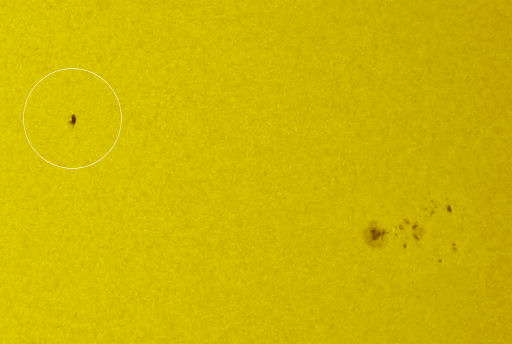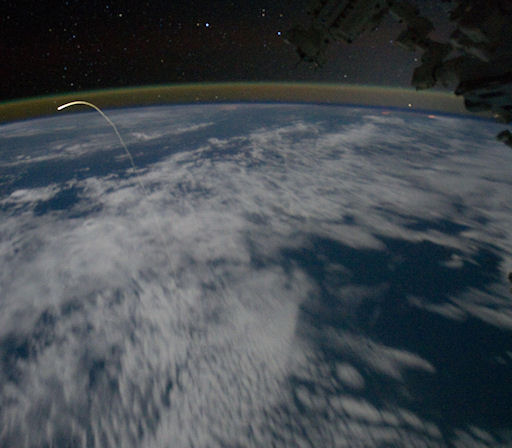They came from outer space--and you can have one! Genuine meteorites are now on sale in the Space Weather Store. | | |
COLORFUL SOUTHERN LIGHTS: Last night, the skies over Antarctica filled with colorful lights in response to a solar wind stream buffeting Earth's magnetic field. J. Dana Hrubes sends these amazing images from the Amundsen-Scott research station at the geographic South Pole. High-latitude sky watchers should remain alert for auroras as the solar wind continues to blow.
LAST PICTURE OF ATLANTIS IN SPACE: On Thursday, July 21st, space shuttle Atlantis landed at NASA's Kennedy Space Center, wrapping up the final mission of NASA's space shuttle program. At 08:27:48 UT, just 21 minutes before the deorbit burn, astrophotographer Thierry Legault captured what might be the last picture of Atlantis in space--and it was a solar transit:

Above: Space shuttle Atlantis (circled) and sunspot AR1254
Because Atlantis was passing over Europe in broad daylight, the only way to catch it would be in silhouette against the sun. "I traveled from my home in Paris, France, to Emden city, Germany, to put myself in the transit's path," says Legault. "Skies were cloudy, but fortunately the transit occurred in a clear gap. Its duration was only 0.9 seconds and Atlantis, from a distance of 566 km (350 miles), appeared on four images."
Readers, do you have a picture of Atlantis in space taken after 08:27:48 UT on July 21st? If so, submit your images here.
The crew of the International Space Station photographed Atlantis even closer to landing, but the orbiter was no longer technically in space. It was reentering Earth's atmosphere:

The green band of light that Atlantis is plunging into is called "airglow." Airglow is a luminous bubble that surounds our entire planet, decorating the top of the atmosphere with aurora-like color. Although airglow resembles the aurora borealis, its underlying physics is different. Airglow is caused by an assortment of chemical reactions in the upper atmosphere driven by solar ultraviolet radiation; auroras, on the other hand, are prompted by gusts of solar wind.
more images: from Thierry Legault of Paris, France; from Andrew Cool of The Heights Observatory, Modbury Heights Adelaide, South Australia; from Christopher Handler of Mt Lofty, South Australia, Australia; from Wim Filmalter of Riversdale, Western Cape Province, South Africa; from Rob Carew of Melbourne, Australia; from Rudie Loots of Somerset West, South Africa; from Mike C of Prairieville, LA;
2011 Noctilucent Cloud Gallery
[previous years: 2003, 2004, 2005, 2006, 2007, 2008, 2009]
June 2011 Aurora Gallery
[Aurora alerts: text, voice] [previous Junes: 2010, 2008, 2001]

